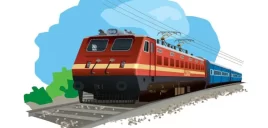Each zonal railway of IR has a fleet of freight wagons that it owns. Of necessity, most freight trains traverse through territory of more than one zonal railway, and wagons of one railwy may end up outside their home zone after a run. Wagon Pooling refers to the practice of allowing other zonal railways to use the wagons for their own freight trains. In effect, the wagons from all zonal railways are ‘pooled’ together and scheduled for goods trains indiscriminately, without a zone giving preference to wagons it owns. Pooling generally increases wagon utilization, since it avoids transshipment from one zone’s wagons to another zone’s wagons at zonal boundaries, and also avoids having wagons return empty to their home railway. It also minimizes shunting as a result and improves yard and siding utilization.
Generally speaking, most wagons used for long-distance freight are pooled wagons and participate in the pooling. See below for non-pooled and local traffic wagons which do not participate in wagon pooling.
Wagon pooling is also applied outside IR. Wagons may be pooled with non-IR organizations such as industrial plants (power stations, collieries, mines, cement works, etc.). Additional, wagons are also pooled with foreign railways such as Bangladesh Railway and Pakistan Railways. IR wagons venture on to the Pakistani and Bangladeshi networks as part of cross-border goods traffic, and similarly wagons from those railways enter IR’s network. These wagons do not have to return immediately, and may be used for goods movements outside their home railways – but usually these are returned fairly soon.
Obviously, with wagon pooling a concern that arises is how wagons are to be maintained and overhauled. As a general rule, wagons are to return to their home railways every 3 years for periodic overhaul (POH). This is usually indicated as a stencilled notation, e.g., ‘Return 7/93’ indicating a return required to the home railway by June 1993. Ordinary inspection and most minor maintenance at yards and at stations en route is of course carried out by whichever railway happens to have the wagons at the time. (In fact, wagons cannot be interchanged if they have serious defects; the railway which has the wagon at the time then must fix the defect.)
The Directorate of Wagon Interchange (DWI) under the IRCA is responsible for coordinating all wagon interchanges across IR. Officers in charge of wagon interchange are assigned to each nodal point where interchange occurs.
Each railway’s wagons are enumerated and kept track of. Based on the goods traffic needs of a particular railway, it may require more or fewer wagons than it actually owns. A creditor railway is one which needs fewer wagons than it needs, so that its surplus wagons are, in effect, ‘loaned’ out to other railways. A debtor ralway, similarly, is one which needs more wagons than it has, so that it has to ‘borrow’ wagons from the wagon pool for its operations. For the privilege of using wagons over the number that a railway owns, it has to pay rental charges. These hire charges vary by type of wagon. As an example, 4-wheeled BG wagons had hire charges of Rs 66 a day in the 1970s. Currently [2010] they are around Rs 387 a day. Industrial (non-IR) users were charged Rs 1038, Bangladesh Railway Rs 665, and Pakistan Railway Rs 1000. Hire charges for MG wagons are around Rs 204 a day, for non-railways users Rs 464, and for BR, Rs 290.
The DWI computes the Pool Target for each zonal railway which is the number of pooled wagon it can have at any time in order to run its expected goods operations smoothly. These are often denoted relative to the number of wagons the railway owns: A pool target of +2000 implies that the zonal railway must do with 2000 fewer wagons than it owns, and therefore must be a creditor railway. Similarly, a pool target of -2000 implies the railway is a debtor railway and will use 2000 more wagons than the number it owns. As excessive holdings of wagons by a particular zonal railway leads to inefficiency, the DWI is empowered to instruct railways to reduce their holdings, and impose fines when pool targets are not maintained.
At each Interchange Point, or junction where interchange occurs between railways, goods traffic needs to be regulated to maintain traffic flow, as well as to ensure adherence to pool targets. For this purpose, Junction Quotas are determined, which specify the number of wagons to be interchanged each day between individual railways at the interchange point, in each direction. Junction quotas in the case of highly asymmetric traffic routes may specify a particular number of empties to be returned in the reverse direction. The railway that works the junction or interchange point is known as the Working Railway, and the other railways interchanging their wagons at that junction are called the Using Railways. A wagon is interchanged between the working railway and the using railway when it enters or leaves the junction. Equalization is the process of ensuring that the flow of wagons between two interchanging railways is equal in both directions at the interchange point. This is not always the case, when traffic flows are not symmetric. Overequalization refers to a railway handing over more wagons than it receives in return; the opposite situation is Underequalization. For instance, NR hands over coal wagons from ER to WR at Agra East Bank, and is overequalized with WR, because WR does not return the wagons to NR by the same route. WR hands over the released empties to CR in the return direction – it is overequalized with CR; the empties pass over CR to Ajni and Katni to SER and back to the colliery regions. The situation can be more complex if the wagons are not returning empty but being used for some other highly directional goods traffic on the return trip. The DWI issues instructions regarding junction quotas and equalization. Strict equalization is not always required – railways often overequalize with another railway at one junction but underequalize by a matching amount at another.
As the working railway is placed at a disadvantage since it holds wagons at its junction even though it is not utilizing them, a Junction Allowance used to be specified to compensate for the extra wagon hours at the junction; this has since been dispensed with.
An Interchange Message noting the total numbers of wagons interchanged over a day may look like the following (example from Railway Operation by Francis DaCosta).
| MGS 5/1 |
| RAILCON-NDLS C/-COPS NDLS CCC DS NR |
| 20 JN – Interchange midngiht ending 4.1.80 |
| AD |
2813 |
CL |
1073 |
CE |
28 |
OL |
1709 |
OE |
3 |
| DA |
3085 |
CL |
493 |
CE |
826 |
OL |
1125 |
OE |
641 |
|
In the above interchange message which records the total interchanges as of midnight following the working day, A stands for ER, and D for NR. C = Covered wagons and O = Open wagons. L = Loaded, E = Empty.
In addition to the aggregate information about numbers of interchanged wagons, individual car movement records are also maintained, so that overdue or missing wagons can be identified easily. The divisional wagon balance is calculated as of midnight each day.
At each interchange junction, wagons to be interchanged are inspected. A defect found in a wagon may be classified as a Penalty Defect in some cases, and is racked up as a debit to the railway offering the wagon. A defect that is serious enough that the wagon cannot be used is classified as a Rejection Defect and the wagon remains with the offering railway, which may offer it again after fixing the problem. No actual monetary fines are levied; but the statistics on defects provide an indication of the level of maintenance of wagons by a railway. Rejection defects increase the holdings of wagons on a railway’s books, and therefore may render it liable for fines if it exceeds its pool targets as a result.
History: Originally, with the separate railways that existed in India, there was no concept of wagon pooling. Each railway useds its own wagons on its lines, and wagons from foreign railways were operated only by specially negotiated agreements among the railways. For instance, much coal loaded by the East Indian Railway was done on its own wagons, and transshipped to wagons of other railways at transshipment points. The inefficient utilization of the wagons in the prevailing system became very apparent during World War 1 when the demands of goods traffic rose sharply. Emergency orders were issued allowing indiscriminate loading of goods on any available wagons regardless of which railway owned them. The Indian Railway Conference Association (IRCA) carried out a review of the new practice and after further experiments, in 1925 it was decided as a policy that wagons should generally be pooled. The IRCA was given control over the wagon interchange policies and procedures.
Wagon pooling at first applied only to BG wagons. As there were many more – and very small – railways operating on MG, it took longer to coordinate the arrangements for wagon pooling among them. The MG network of northern India had wagon pooling from 1939, and the southern MG network had wagon pooling from 1950.
Source – IFRCA.org
This entry was posted in 2 Railway Employee, STUDY NEW, Railway Employee











